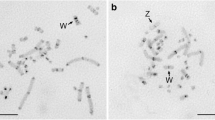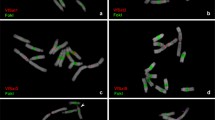Abstract
During the screening of aDrosophila melanogaster YAC library with DNA from the minichromosomeDp(1;f)1187 we isolated a clone, yw20D5, which contains a new subtype of 1.688 satellite DNA. Although the sequences of several monomers subcloned from the YAC show a considerable variation in length, the derived consensus sequence is 356-bp long. This new subtype and the one constituted by the 353-bp repeats are both located on the left arm heterochromatin of chromosome 3, arranged in separate arrays. Despite their autosomal location, phylogenetic relationships among 1.688 satellite sequences suggest that they may have originated from the 359-bp repeats of the X chromosome heterochromatin. We have used the new 356-bp repeats to investigate whether sequences related to the 1.688 satellite are dispersed along the euchromatic arms of the autosomes in a similar way to that in which they are found along the X chromosome euchromatin.
Similar content being viewed by others
References
Abad JP, Carmena M, Baars S et al. (1992) Dodecasatellite: a conserved G+C-rich satellite from the centromeric heterochromatin ofDrosophila melanogaster.Proc Natl Acad Sci USA 89: 4663–4667.
Adachi Y, Luke M, Laemmli UK (1991) Chromosome assemblyin vitro: DNA topoisomerase II is required for condensation.Cell 64: 137–148.
Anand R, Villasante A, Tyler-Smith C. (1989) Construction of yeast artificial chromosome libraries with large inserts using fractionation by pulsed field gel electrophoresis.Nucleic Acids Res 17: 3425–3433.
Baker BS, Gorman M, Marin I. (1994) Dosage compensation inDrosophila.Annu Rev Genet 28: 491–521.
Burke DT, Carle GF, Olson MV (1987) Cloning of large segments of exogenous DNA by means of artificial chromosome vectors.Science 236: 806–812.
Carlson M, Brutlag D (1977) Cloning and characterization of a complex satellite DNA fromDrosophila melanogaster.Cell 11: 371–381.
Carmena M, Abad JP, Villasante A, González, C (1993) TheDrosophila melanogaster dodecasatellite sequence is closely linked to the centromere and can form connections between sister chromatids during mitosis.J Cell Sci 105: 41–50.
DiBartolomeis SM, Tartof KD, Jackson, FR (1992) A superfamily ofDrosophila satellite related (SR) DNA repeats restricted to the X chromosome euchromatin.Nucleic Acids Res 20: 1113–1116.
Felsenstein J (1985) Confidence limits of phylogenies: an approach using the bootstrap.Evolution 39: 783–791.
Foe VE, Alberts BM (1985) Reversible chromosome condensation induced inDrosophila embryos by anoxia: visualization of interphase nuclear organization.J Cell Biol 100: 1633–1636.
Gatti M, Bonaccorsi S, Pimpinelli S (1994) Looking atDrosophila mitotic chromosomes. In: Goldstein LSB, Fyrberg EA, eds. Drosophila Melanogaster:Practical Uses in Cell and Molecular Biology. San Diego: Academic Press, pp 372–391.
Hiraoka Y, Dernburg AF, Parmelee SJ et al. (1993) The onset of homologous chromosome pairing duringDrosophila melanogaster embryogenesis.J Cell Biol 120: 591–600.
Hsieh, T, Brutlag D. (1979) Sequence and sequence variation within the 1.688 g/cc satellite DNA ofDrosophila melanogaster.J Mol Biol 135: 465–481.
Karpen GH, Spradling AC (1990) Reduced DNA polytenization of a minichromosome region undergoing position-effect variegation.Cell 63: 97–107.
Karpen GH, Spradling AC (1992) Analysis of subtelomeric heterochromatin in theDrosophila minichromosomeDp1187 by single P element insertional mutagenesis.Genetics 132: 737–753.
Käs E, Laemmli UK (1992)In vivo topoisomerase II cleaage of theDrosophila histone and satellite III repeats: DNA sequence and structural characteristics.EMBO J 11: 705–716.
Kumar S, Tamura K, Nei M (1994) MEGA: molecular evolutionary genetic analysis software for microcomputers.Comput Appl Biosci 10: 189–191.
Lilley DMJ (1988) DNA opens up: supercoiling and heavy breathing.Trends Genet 4: 111–114.
Lindsley DL, Zimm GG (1992)The Genome of Drosophila melanogaster. New York: Academic Press.
Lohe AR, Brutlag D (1986) Multiplicity of satellite DNA sequences inDrosophila melanogaster.Proc Natl Acad Sci USA 83: 696–700.
Lohe AR, Hilliker AJ, Roberts PA (1993) Mapping simple repeated DNA sequences in heterochromatin ofDrosophila melanogaster.Genetics 134: 1149–1174.
Lowenhaupt K, Rich A, Pardue ML (1989) Nonrandom distribution of long mono- and dinucleotide repeats inDrosophila chromosomes: correlations to dosage compensation, heterochromatin and recombination.Mol Cell Biol 9: 1173–1182.
Madueño E, Papagiannakis G, Rimmington G et al. (1995) A physical map of the X chromosome ofDrosophila melanogaster: cosmid contigs and sequence tagged sites.Genetics 139: 1631–1647.
Pardue ML (1994) Looking atDrosophila polytene chromosomes. In: Goldstein LSB, Fyrberg EA, eds. Drosophila Melanogaster:Practical Uses in Cell and Molecular Biology. San Diego: Academic Press, pp 334–351.
Pirrotta V, Hadfield C, Pretorius GHJ (1983) Microdissection and cloning of the white locus and the 3B1-3C2 region of theDrosophila X chromosome.EMBO J 2: 927–934.
Quian S, Pirrotta V (1995) Dosage compensation of theDrosophila white gene requires both the X chromosome environment and multiple intragenic elements.Genetics 139: 733–744.
Royle NJ, Clarkson RE, Wong Z, Jeffreys AJ (1988) Clustering of hypervariable minisatellites in the proterminal regions of human autosomes.Genomics 3: 352–360.
Saitou N, Nei M. (1987) The neighbor-joining method: a new method for constructing phylogenetic trees.Mol Biol Evol 4: 406–425.
Strachan T, Webb D, Dover GA (1985) Transition stages of molecular drive in multiple-copy DNA families inDrosophila.EMBO J 4: 1701–1708.
Warburton PE, Willard H (1990) Genomic analysis of sequence variation in tandemly repeated DNA.J Mol Biol 216: 3–16.
Waring GL, Pollack JC (1987) Cloning and characterization of a dispersed, multicopy, X chromosome sequence inDrosophila melanogaster.Proc Natl Acad Sci USA 84: 2843–2847.
Zuckerkandl E (1992) Revisiting junk DNA.J Mol Evol 34: 259–271.
Author information
Authors and Affiliations
Additional information
accepted for publication by D. Ward
Rights and permissions
About this article
Cite this article
Losada, A., Villasante, A. Autosomal location of a new subtype of 1.688 satellite DNA ofDrosophila melanogaster . Chromosome Res 4, 372–383 (1996). https://doi.org/10.1007/BF02257273
Received:
Accepted:
Issue Date:
DOI: https://doi.org/10.1007/BF02257273




